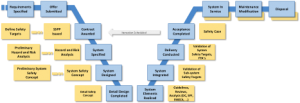Together with my co-authors, Dieter Fasol and Peter Bunus, I am happy to announce that we successfully submitted the contribution “A Model-Based Safety and Dependability Methodology for Missile Safety Engineering” at the 33rd International System Safety Conference (ISSC2015) taking place right this week, Aug 24-27 2015 in San Diego, California.
ISSC 2015 San Diego
The ISSC is the premiere international conference on system safety. The conference theme for 2015 is “Exploring the Future of System Safety” intended to explore and learn how system safety can benefit from the past and project that knowledge into the future to improve performance, reduce failures and prevent accidents in complex systems. As the organizers state, “this conference will bring practitioners and the foremost thinkers of the system safety discipline together for an exchange of ideas, knowledge and experiences.”
Here is the abstract of our paper:
 Model-based methods are becoming more prevalent to support system development processes while in the field of Safety and Dependability (S&D) this adoption is slower. This contribution reports about model based S&D engineering along the V-model from concept to operation phase in an industrial application. In the concept phase, the design engineer has the complex task to find an architecture fulfilling safety, reliability, availability and testability targets.
Model-based methods are becoming more prevalent to support system development processes while in the field of Safety and Dependability (S&D) this adoption is slower. This contribution reports about model based S&D engineering along the V-model from concept to operation phase in an industrial application. In the concept phase, the design engineer has the complex task to find an architecture fulfilling safety, reliability, availability and testability targets.
We propose a qualitative modeling approach in which, during the early stage of design, models can be quickly built to support the full range of S&D analyses such as: computation of cause-effect relationships, automatic generation of FTAs, automatic generation of RBDs, system availability prediction or systematic evaluation of the Diagnostic Coverage. At this stage, the qualitative model supports the system and subsystem specifications’ validation process and provides a systematic framework to reduce the risk of not meeting the RAMST targets.
 Later in the development cycle a full quantitative model is built (semi-automatically from importing the ECAD-net lists) using component model libraries. While maintaining drawing set consistency of analysis results, this final model quickly unveils the safety impacts of design changes, enables automated computation of even double-fault FMECAs and supports model-based diagnostics during operation of the system.
Later in the development cycle a full quantitative model is built (semi-automatically from importing the ECAD-net lists) using component model libraries. While maintaining drawing set consistency of analysis results, this final model quickly unveils the safety impacts of design changes, enables automated computation of even double-fault FMECAs and supports model-based diagnostics during operation of the system.
The live presentation of this topic this morning raised quite good interest. You may read more about the idea behind the paper on the website www.dependability.info or download the full article here.